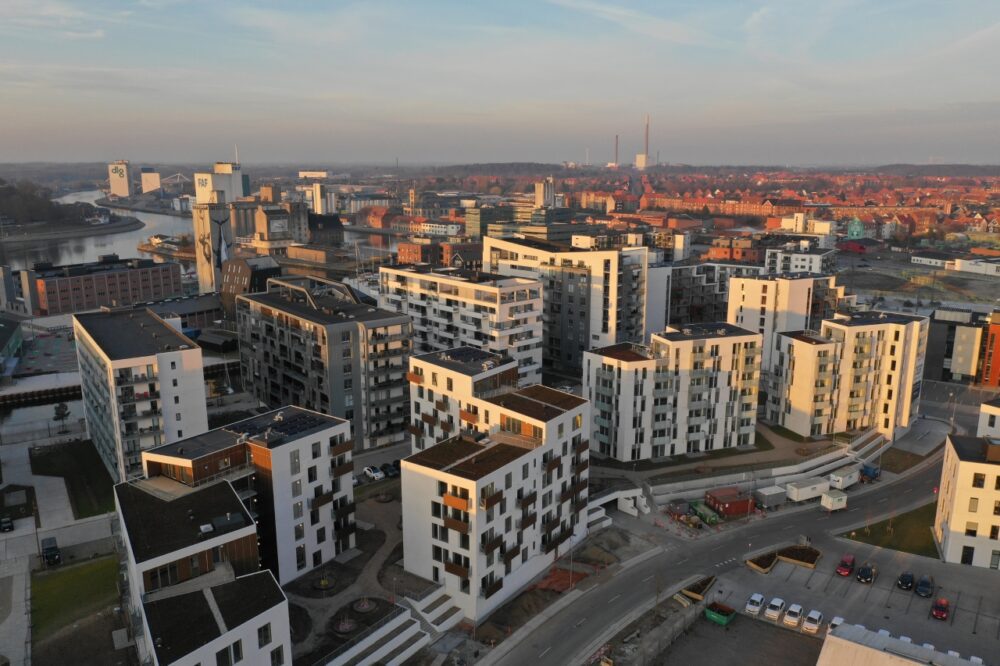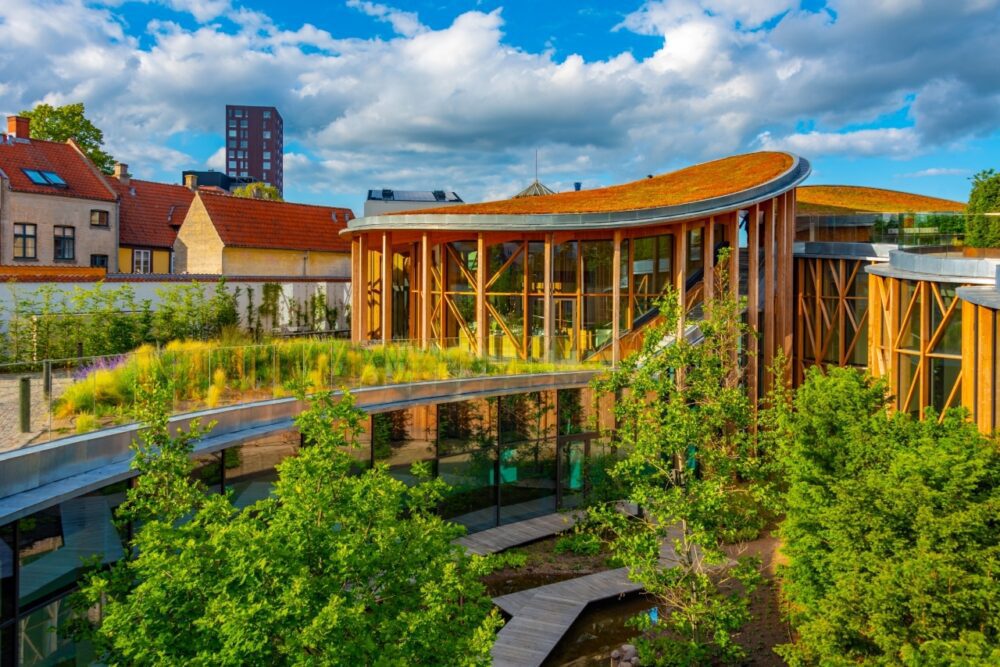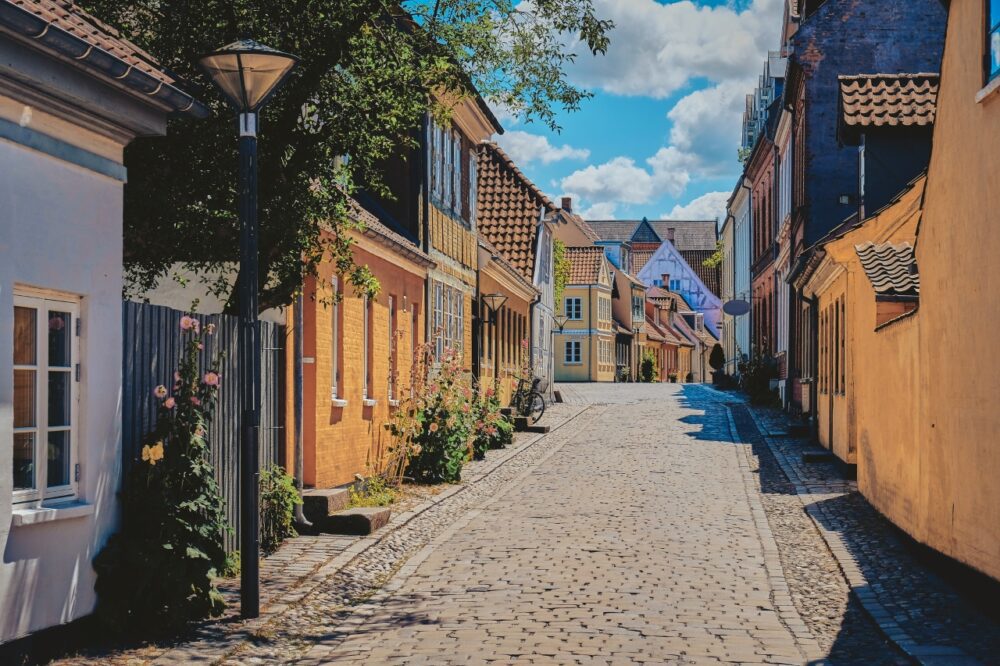
Is Odense worth visiting? Absolutely! When I first explored Odense, I was charmed by its storybook atmosphere and relaxed pace. Walking along its cobblestone streets, I couldn’t help but feel like I’d stepped into the pages of a Hans Christian Andersen tale—fitting, as this city is the birthplace of the beloved fairy tale writer.
Located on the island of Funen, Odense is Denmark’s third-largest city and a treasure trove of history and culture. It’s a place where centuries-old architecture meets modern Scandinavian design, creating a blend that feels timeless yet fresh. Whether you’re exploring the Hans Christian Andersen Museum, biking along scenic canals, or enjoying the cosy café culture, Odense has a way of making you feel at home while sparking your curiosity. But is Odense worth visiting for you?
In this blog post, we’ll uncover the top 10 reasons why Odense should be on your travel list, from its rich literary heritage to its vibrant cultural scene. Plus, we’ll share practical travel tips to help you plan the perfect visit. Keep reading, and you’ll see why this Danish gem deserves a spot on your itinerary.
Table of Contents
Pros – Reasons You Should Visit Odense
1. The Birthplace of Hans Christian Andersen

Odense is best known as the birthplace of Hans Christian Andersen, one of the most famous fairy tale writers in history. His legacy is everywhere in the city, from museums dedicated to his life to sculptures depicting his beloved characters. The Hans Christian Andersen Museum is a must-visit, offering an interactive experience that brings his stories to life through exhibits, multimedia displays, and personal artifacts.
I loved wandering through the old town, where Andersen spent his early years, visiting his childhood home, which has been preserved as a museum. Walking through the cobblestone streets lined with colorful houses, I felt as if I had stepped into one of his fairy tales. Even if you’re not a huge Andersen fan, the city’s deep connection to literature and storytelling makes it a fascinating place to explore.
2. A Charming and Walkable Old Town

Odense’s old town is a delight to explore, with its narrow cobblestone streets, half-timbered houses, and cozy cafés. Unlike larger cities that can feel overwhelming, Odense has a relaxed, small-town charm that makes wandering through its streets a pleasure. Many of the main attractions are within walking distance, meaning you can easily spend a day strolling through the historic center without needing public transportation.
I spent hours walking through the old town, stopping at boutique shops and charming cafés along the way. There’s a peaceful atmosphere here that’s hard to find in bigger cities, and because it’s not as touristy as Copenhagen, it feels more authentic. The slow pace of life makes it a great place to unwind while still enjoying plenty of history and culture.
3. Green Spaces and a Strong Connection to Nature
Odense is one of Denmark’s greenest cities, with plenty of parks, gardens, and scenic walking paths. Munke Mose Park, located near the city center, is a beautiful green space where locals go for picnics, boat rides, and leisurely walks. The Odense River runs through the park, adding to its scenic beauty and making it a great spot to relax on a sunny day.
I took a walk along the river and was surprised at how peaceful it felt despite being close to the city center. The combination of water, trees, and open space made it a perfect escape from sightseeing. If you enjoy cycling, Odense is also one of Denmark’s most bike-friendly cities, with dedicated bike lanes and plenty of scenic routes through nature.
4. A Family-Friendly Destination with Interactive Museums
Odense is a great city for families, with plenty of attractions that are both fun and educational. In addition to the Hans Christian Andersen Museum, the city is home to the Danish Railway Museum, where kids and adults alike can explore historic steam trains, take part in interactive exhibits, and even hop on a vintage train ride.
I visited the Danish Railway Museum and was impressed by how hands-on it was. Unlike some museums where everything is behind glass, here you can climb into old train carriages, explore different types of locomotives, and learn about Denmark’s railway history in an engaging way. It’s a perfect stop if you’re traveling with children or if you just love trains.
5. Odense Zoo – One of the Best in Denmark
Odense Zoo is often ranked as one of the best zoos in Denmark, offering a mix of exotic animals, interactive exhibits, and beautiful natural enclosures. The zoo is well-designed, making it easy to walk through while feeling immersed in different environments, from the African savannah to the Arctic tundra.
I spent an afternoon at Odense Zoo and was particularly impressed with the open enclosures and the variety of animals. The giraffe feeding experience was a highlight, and I also enjoyed the penguin exhibit, where you can watch them swim through clear underwater tunnels. Unlike larger zoos, this one feels intimate and well-maintained, making it a great stop for visitors of all ages.
6. A Vibrant Food Scene with Local and International Flavors
Odense’s food scene is a pleasant surprise, offering a mix of traditional Danish cuisine and international flavors. The city has a growing reputation for its farm-to-table restaurants, which focus on fresh, locally sourced ingredients. Whether you’re looking for classic Danish open-faced sandwiches (smørrebrød), fresh seafood, or modern Nordic dishes, you’ll find plenty of great options.
I had one of the best meals of my trip at a small bistro that specialized in local Danish ingredients, including fresh fish and seasonal vegetables. The food felt simple yet refined, with a focus on quality rather than complexity. There’s also a great selection of bakeries and cafés where you can enjoy fresh pastries and locally roasted coffee. If you’re a food lover, Odense offers plenty of delicious experiences.
7. The Cultural and Creative Energy of the City
Odense has a strong cultural scene, with plenty of theaters, art galleries, and music venues. The city hosts a variety of festivals throughout the year, including the Odense International Film Festival and the Hans Christian Andersen Festival, which brings fairy tales to life with street performances, plays, and special exhibits.
I visited during the Hans Christian Andersen Festival, and it was magical to see actors dressed as characters from his stories, performing in the streets and interacting with visitors. Even outside of festival season, the city’s artistic energy is evident in its vibrant street art, creative installations, and local galleries showcasing Danish artists.
8. A Great Alternative to Copenhagen
While most visitors to Denmark head straight to Copenhagen, Odense offers a quieter and more relaxed alternative. It has many of the same attractions that make Copenhagen appealing—history, culture, and great food—but without the high prices and overwhelming crowds. Since it’s centrally located on the island of Funen, it’s also a great place to stop if you’re traveling between Copenhagen and Jutland.
I found Odense to be a great place to slow down and take in the surroundings without feeling rushed. Unlike Copenhagen, where you often have to battle crowds at major attractions, Odense feels more personal and inviting. If you’re looking for a Danish city with charm but fewer tourists, Odense is a fantastic choice.
9. Easy to Explore by Bike
Like the rest of Denmark, Odense is extremely bike-friendly, with dedicated cycling paths and a well-connected network of routes that make getting around easy. Whether you want to explore the old town, ride through parks, or take a scenic bike ride along the river, cycling is one of the best ways to experience the city.
I rented a bike for a day and found it to be the perfect way to explore. The city is flat, making it an easy ride even for those who aren’t experienced cyclists. There are also plenty of bike rental shops, and the locals are used to sharing the roads with cyclists, making it a stress-free way to get around.
10. A Gateway to Funen’s Beautiful Countryside

Odense is located on the island of Funen, often called the “Garden of Denmark” because of its rolling hills, orchards, and picturesque coastal villages. If you want to explore beyond the city, there are plenty of charming small towns, castles, and scenic countryside spots just a short drive or bike ride away.
I took a day trip to Egeskov Castle, one of the best-preserved Renaissance castles in Europe. The castle grounds are stunning, with beautiful gardens, hedge mazes, and even a treetop walkway. If you love the idea of exploring Denmark’s countryside, Odense makes a perfect base for discovering the island of Funen.
Cons – Things to Consider When Visiting Odense
1. Odense is a Small City with Limited Attractions
While Odense has a lot of charm and historical significance, it is much smaller than other European cities, and visitors may find that there isn’t as much to do compared to destinations like Copenhagen or Aarhus. The main attractions, including the Hans Christian Andersen Museum, Odense Castle, and the old town, can easily be explored in a day or two. After that, some travelers may feel like they’ve run out of major sights to see.
I spent three days in Odense, and by the second afternoon, I had covered most of the key landmarks. While I enjoyed the slower pace and took my time exploring, I realized that unless you’re interested in diving deep into Andersen’s life or taking day trips to the surrounding countryside, there isn’t a long list of must-see places. If you’re someone who prefers fast-paced travel with endless museums, nightlife, and cultural events, Odense may not keep you entertained for long.
2. The Weather Can Be Unpredictable and Often Rainy
Like much of Denmark, Odense experiences unpredictable weather, with frequent rain and cloudy skies, even during the summer months. Winters are cold, dark, and damp, making outdoor activities less appealing, while spring and autumn can be hit-or-miss with sudden downpours and cool winds. Even in July and August, when the weather is supposed to be at its best, there’s still a good chance of encountering grey skies and drizzle.
I visited in early September and was met with a mix of sunshine, sudden rain showers, and chilly breezes. Walking through the old town was pleasant when the sun was out, but the moment the rain started, it quickly became less enjoyable, and there weren’t many indoor attractions to take shelter in. If you’re planning a trip, it’s best to pack layers, bring a good raincoat, and always have an umbrella on hand. Checking the forecast before heading out for the day is also a smart idea, as the weather can change quickly.
3. The Nightlife Scene is Limited
Odense is a university town, which means there are some bars and pubs catering to students, but overall, the nightlife is not as lively or diverse as in Copenhagen or even Aarhus. There are a handful of cozy pubs, craft beer bars, and the occasional live music venue, but if you’re looking for big nightclubs, late-night entertainment, or a high-energy party scene, Odense might feel a bit too quiet.
I went out on a Friday night expecting a buzzing nightlife atmosphere, but by midnight, many places were already closing, and the ones that were open weren’t particularly crowded. While the local bars were enjoyable for a drink and conversation, the city doesn’t have the kind of nightlife that would attract those looking for an all-night party. If you prefer a more relaxed evening with a few drinks rather than a clubbing scene, Odense might suit you just fine, but if you’re expecting a dynamic nightlife experience, you might be disappointed.
4. Public Transport is Not as Efficient as in Larger Danish Cities
Unlike Copenhagen, which has a well-developed metro, bus, and train system, Odense’s public transportation is more limited. While the city does have a bus network, it isn’t always the most convenient or frequent, especially in the evenings or on weekends. Some of the best places to visit, such as Egeskov Castle or the coastal villages on Funen, require a car or a long, sometimes complicated bus journey.
I found that while getting around the city center was easy on foot or by bike, traveling beyond it took more effort. Buses didn’t always run on time, and some routes only had a few departures per day. If you’re planning on exploring outside the main town, renting a bike or a car will make your trip much smoother. Relying on public transportation can be frustrating, particularly if you’re trying to fit multiple sights into one day.
5. Some Restaurants and Shops Close Early
Odense has a relaxed, small-town atmosphere, which means that many restaurants, shops, and even some attractions close earlier than you might expect. Outside of peak summer months, it’s common for businesses to shut down by 5 or 6 PM, and even many restaurants stop serving food relatively early compared to larger cities. If you’re used to dining late or enjoying an evening stroll through open shops, you might find the early closing hours frustrating.
I tried to grab dinner at a well-rated restaurant one evening around 8:30 PM, only to find that the kitchen had already closed. Similarly, some cafés and shops I wanted to visit had already shut their doors by the late afternoon. While this slow pace adds to Odense’s charm, it also means that planning ahead is necessary if you want to make sure you get to experience the best of the city. Checking opening hours in advance and making reservations for dinner can help avoid disappointment.
When to Visit Odense
The best times to visit Odense are late spring (May to June) and early autumn (September), when the weather is mild, and the city’s parks, like Munke Mose and Eventyrhaven, are at their most colourful. These shoulder seasons allow you to enjoy Odense’s historic charm and outdoor attractions without the summer crowds. Summer (July and August) is the busiest time, with warm weather and lively festivals like the Hans Christian Andersen Festival, which brings the city’s fairy-tale heritage to life. December is a cosy option for winter travellers, as Odense’s Christmas markets and decorated streets make for a festive experience.
How to Get to Odense
The nearest major airport to Odense is Copenhagen Airport (CPH), which is well connected to cities around the world. From the airport, regular trains run directly to Odense and take about 1.5 hours. Billund Airport (BLL), around 100 kilometres away, is also an option with flights from several European destinations, and offers buses and shuttle services to Odense. Odense is easily accessible by train from Copenhagen and other Danish cities, making it a convenient destination for those exploring Denmark by rail.
Where to Stay in Odense
Odense offers a variety of accommodation options across its charming neighbourhoods:
- Luxury: City Centre – Close to landmarks like Hans Christian Andersen Museum and St. Canute’s Cathedral, this area is ideal for visitors who want to be in the heart of the city. Top choices include Hotel Odeon and First Hotel Grand, which offer upscale amenities and historic surroundings.
- Mid-range: Vesterbro – A vibrant area with plenty of cafes, restaurants, and parks, located within walking distance of the city centre. Milling Hotel Plaza and Radisson Blu H.C. Andersen Hotel provide comfort and style at reasonable prices.
- Budget: Dalum – A residential neighbourhood just south of the city centre, with good public transport links. Danhostel Odense City and CABINN Odense Hotel offer budget-friendly options with easy access to the main sights.
Getting Around Odense
Odense’s compact layout makes it a pleasant city to explore on foot, with many attractions close together. For longer trips, the Fynbus network provides convenient and affordable transport around the city and surrounding areas, with single tickets and day passes available. Odense is also a bike-friendly city, with a popular bike-sharing system, Bycyklen, allowing visitors to rent bikes and explore scenic routes, including paths along the Odense River. For an alternative view, try a riverboat tour, which gives you a unique perspective of the city from the water.
How Long to Spend in Odense
Two days is ideal for exploring Odense, giving you enough time to see the Hans Christian Andersen Museum, Funen Village, and Odense Zoo, and to experience the relaxed pace of the city. With an extra day, you could take a day trip to Egeskov Castle, a stunning Renaissance castle with beautiful gardens just a short drive from Odense. If you’re a fan of Andersen’s work or want to enjoy more of Odense’s parks and cafes, a three-day stay allows for a deeper dive into the city’s charming mix of history, culture, and green spaces.
Conclusion
So, is Odense worth visiting? Definitely! With its charming streets, deep connection to Hans Christian Andersen, and a perfect mix of history and modernity, Odense offers a uniquely Danish experience. Highlights like the Andersen Museum, the picturesque Old Town, and the tranquil green spaces make it a destination full of character. While it’s quieter than cities like Copenhagen, its intimate charm and welcoming atmosphere more than make up for it. If you’re ready to dive into the heart of Danish culture and history, start planning your trip to Odense today!
